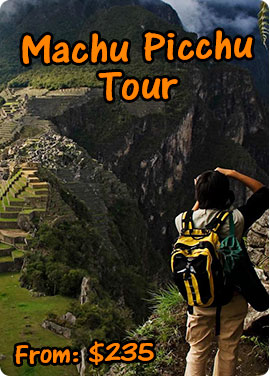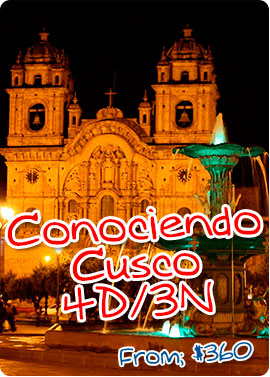Chinchero description:
Chinchero:
Chinchero is at an altitude of 3,750 m. s. n. m. m. The area belongs to a plateau or Andean altiplano; Geographically, it belongs to an area or ecosystem Quechua, very important area of agricultural production, especially potatoes.
Etymologically, the Quechua word Chinchero, may come from the term: chinchay, which is a feline of important Andean ideology. Since the preceramic period is area had human occupation as an important ecosystem for life; it is possible that in these ancient times Chinchero environment has been very different and that has changed from that time to our giving a new geo-climatic typology.
It is important to note that in Chinchero still continues one of the most traditional forms of inka socioeconomic system, ie the sociocomunal Ayllu system: this is a palpable proof that the Andean culture has not disappeared.
Since pre-Hispanic times to date, Chinchero is divided into four areas: one Urin sector. Hanan one sector. one Lloque sector, Phana sector. Within this division, we find the Tawantinsuyo system of urban and Andean ideology; so in this divided into four area are currently peasant communities: Kuper, Korikancha, Ayllu punku, Umasoamna, Tanqa, Supiri, Chuso and Yanacona. The Division of the quadripartite function was adopted by Hispanics and represented by four arches, whom the Spaniards said they were the Four Evangelists, the Four Doctors of the Church, but for ancient Andean priests still represent the ancestral ideology of Tawa ( four); that is why, not only this town but in others as well, the Andean religious aspect, which is symbiotic, continues to persist and maintain its strength and vigor; so for foreign situation, Catholicism was taken as an element to cover and remove them ancestral beliefs, thus its destruction; appreciate this even in the famous Chuqchayrut’ukuy (haircut) in the (very different from the Catholic or civil marriage) traditional marriages, Ch’ullasqa which is a type of greeting and payment, or offering T’inqaska when you start something, the Samischasqa is a kind of gratitude, the Chasquiska receiving etc. This can be seen in a vivencial in this area communities, ie, we are feeling an element of latent survival of Andean culture.
Perform an itemized explanation of the Inca part and Chinchero colonial part is quite difficult, so we have to make an integrated analysis.
In the area of Chinchero archaeological find: carved rocks, platforms (agricultural terraces), canal systems, places of worship, residential buildings and utilitarian; many of these buildings have been adapted and exploited to build colonial buildings, though today a good number of buildings of Inca origin no later juxtaposition of elements are appreciated, as well as pampas (places).
It should be noted also that in this geographical and social area, still the largest population of traditional weavers remains, with the type of prehispanic loom used by the Quechua, another element that shows cultural survival.
Chinchero, in pre-Hispanic times, was an important sector of agricultural production, there being a major urban center, which was the capital of this marka (province), administrative, social and economic center. In this way, we can say clearly that it was a productive area and then held an administrative sector.
Another element that is important to mention the Inka period Chinchero, is the use of the lagoon Piuray, which was exploited by a number of channels for two purposes: one, the irrigation and the second water transport, also by underground channels, to the city of Cusca, to provide this liquid to the population. In colonial times, by the Viceroy Toledo, it continued to be used this loophole and these channels to keep water surtiendo Cusco.
As regards the main center of concentration of prehispanic architecture, it is the center of Chinchero Inca, which was seized, almost entirely, by the Spaniards. The area was the most important religious and administrative center of this city is where today stands the parish church. Then on the right hand side (entering the church) and on the back, important buildings are seen in many of which the Inca burnt clay floor is; front of the church, is a great Inca wall with a series of trapezoidal niches that might have fulfilled ritual functions or utilitarian and before a large square. The streets are different inka stroke and the bases of the walls, the streets and buildings were used by the Spanish to the colonial city.
In this sector, have now been able to locate three wakas (shrines), even depending where religious services are met, these wakas are as follows:
Titiqaqa
Pumaqaqa
Chinkana
These are outcrops of limestone that were exploited to make these shrines, where cougars are tilled, tianas (seats), stairways and corridors; out of these three shrines there are three more in this area.
Referring to the platforms, a lot of terraces seen, but to the sector of the creek, the platforms attract attention because they do not follow the contour lines, as this village modify the stroke and make right angles and squared, it which gives them a very special configuration.
The Spanish mission from 1966 to 1971, led by Dr. Manuel Ballesteros Gabrois, determines, excavations and research, this Inca city was built during the government of Pachacuteq Inka Yupanqui around 1480 (the most important palaces of Chinchero), but we have note that no chronology is accurate; Also, this mission restored many buildings and walls of pre-Hispanic origin; by investigations of this mission, the presence of a large ceremonial plaza above the farming terraces was determined; also lots of ceramic fragments and other elements is, those that studied and in association with other sectors, demonstrate the Inca origin of this place and its utilitarian use of agricultural character and administrative center.
One element that relatively affected the daily development of this region, as in other areas, was the ritual of war between the Inca and Inca Cusco Wascar Atawallpa outside.
This area of Chinchero was not affected initially by the arrival of the Spaniards and decision Cusco, but with the rise of Manco Inka in 1536 the actions of this inka start with burning Chinchero; since that time declined considerably the activity of this region and there was a notable decline in population, most of its buildings were transformed into corrals and predation began this prehispanic area; was already with the arrival of Viceroy Toledo Chinchero was able to stabilize somewhat in his frank fall; with the ordinances of Toledo (Ordinances is a type of legal mandate), the system is established and Chinchero reductions enters this system; also in order of Toledo, the doctrine of Our Lady of Montserrat Chinchero set, ordered also that a church (from 1571 to 1572, residence of the Viceroy Toledo in Cuzco) was built, which as expected, was erected place on what was most important socio-economic and ideological in this area in ancient times, conception of colonial policy, being the date of construction of the church 1607, a date which is registered in the Arc Toral; to erect the churchyard was covered with earth, ie, a filling of several Inca constructions, some of which were put in value by the excavations of the Spanish mission was made; It must take into account that the Spaniards, on several occasions, used the Inca constructions to their advantage; others by covering it with soil haste and in most cases destroyed, what happened in Chinchero.
In the church several important artistic elements such as are: altars, decorated and painted ceilings, paintings by indigenous painter Chiwant’ito; in one of the paintings are represented the church and bell tower design that has served for the restoration of the belfry and facade of the church.
On the square inka-colonial town of Chinchero, a construction of a colonial house is seen with a balcony that has arches and striking, this was the home of the Spanish Army Brigadier Mateo Garcia Pumaqhawa Chiwant’ito; this individual was governor of the town of Chinchero, belonged to the famous group of exploiters caciques, clear example of the betrayal of his people (Andean village) it is that it was recipient of the royal tributes, recipient of the tithes of the Church (recipient of the parish tithes) was Spanish Army Officer with the rank of colonel, then brigadier, he received the Spanish government paid out of the juicy dividends perceived by the collection of taxes. He was president of the Audiencia of Cusco, fought against Jose Gabriel Tupac Amaru (Revolution 1780-1781) paying troops with his personal peculio to defeat him, command pass the royalist cavalry over the heads of people who had been buried up to his neck in many populations altiplánicas for the sin of Tupac Amaru have supported for wanting to get rid of the situation and alien subjugation; very old and resentful with the king, for various personal reasons, joined the revolution of the Angulo brothers in 1814, was executed by his former allies in robberies in the town of Sicuani.
Finally, we say that in this place a Sunday market develops, but the market and bartering are more elements of colonial character of Inca origin.
Thus, Chinchero was one of the centers of importance in production, as a particular ecosystem, then an administrative center that was used by the Spaniards, as were exploited many other prehistoric sites such as Ollantaytambo, this way we can appreciate an architectural juxtaposition.



